Crowned eagles defy the imagination. No other hunter in Africa is as impressive as this enormous bird of prey.
These beautiful hunters can prey on antelope more than seven times their own bodyweight! They can swoop after monkeys and bushbuck at 160 kilometres per hour, then brake to a complete stop in just six metres!
African crowned eagles were once restricted to the wilderness. But their habitat is disappearing. Now they are even spotted in South African cities and have been known to kill human babies. Here is a safari guide to this astonishing hunter.
The Really Cool Stuff – How Do Crowned Eagles Hunt

Crowned eagles are smaller than martial eagles. Despite being a metre tall with a 1.8 metre wingspan, they only just sneak into the list of Africa’s biggest eagles. Males weigh 2.7-4.1 kilograms and the females are around 15% larger.
So how does a bird weighing 4 kg hunt such enormous prey? Crowned eagles typically prey on monkeys, mongoose, rock hyrax, monitor lizards, snakes, and antelope such as bushbuck and duiker. They have been recorded taking down bushbuck weighing 30 kg!
Genetic brilliance
First you must understand their speed and agility. Crowned eagles have both a long tail and rounded wings. This helps them descend at 160 kph and allows them to weave through the rainforest canopy at high speed.
Their legs are broader and stronger than all other eagles. And they have long hind talons capable of crushing heads and spines.
The ferocious death strike
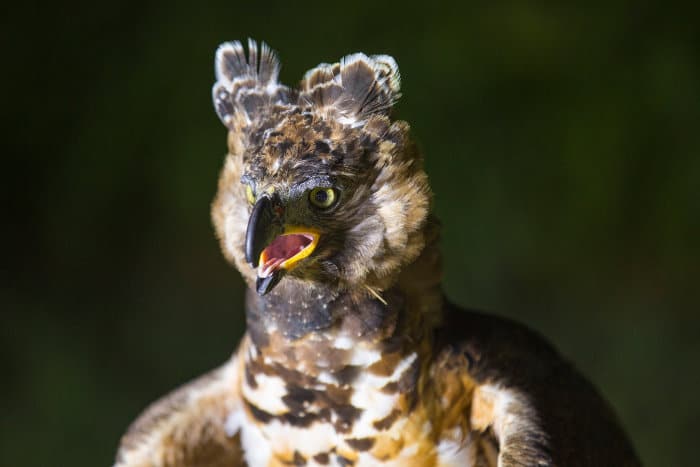
Crowned eagles hunt a lot like leopards. They rely on stealth to get close, then accelerate at speed towards their prey. One moment they appear elegant and beautiful. The next moment they are ferocious and frightening.
Some eagles grab their prey and carry it off. Crowned eagles go straight for the kill. Like leopards they deliver a death strike to the back of the neck, or sometimes the skull.
Crowned eagles usually hunt at dawn or twilight. Their talons are so strong they can crush the skull of a 30 kg antelope. In one swoop they can snap the spine of an animal up to seven times its weight.
Such sharp talons usually kill prey on impact. If not, the animal dies from asphyxiation, or soon passes out from its injuries.
Sometimes a crowned eagle gets gruesome and rams its talons into the skull of its prey, aiming straight for the brain.
Big game hunting tactics
Crowned eagles practice something called still-hunting. They sit still on a tree branch then drop straight onto their prey. Unlike other eagles, they hide inside the tree canopy, rather than on top of it.
This is an easy way for them to hunt antelope such as forest-dwelling duiker. The eagle can wait for many hours on a branch, then in just two seconds it has killed an antelope. It is also their tactic for hunting other forest animals, such as rats, mongoose, and even water chevrotain.
Primates pose a more difficult hunting challenge, especially monkeys in large troops. So crowned eagles hunt in pairs. The male or female distracts the troop with some ferocious flapping. Then the killer glides in undetected to deliver a killer blow.
Sometimes the prey is too big and agile. So crowned eagles use a strike-and-wait hunting assault. After causing a bloody wound with their talons, the eagles use scent to track their victims, sometimes over many days. When the wounded prey struggles to keep pace with the troop or herd, the eagle returns to finish the kill.
Crowned eagles are the only eagle species that successfully hunts monkeys, mangabeys and baboons. They are also the only bird species that strikes and waits.
Diverse prey

Crowned eagles are very adaptable animals, just like leopards. Their diet is mostly made up of mammals, yet preferred prey varies enormously by region.
For example, crowned eagles in South Africa’s Tsitsikamma forest feed mostly on juvenile antelope. A study showed that 22% of their prey were antelopes weighing over 20 kg!
In the rainforest of Taï National Park in the Ivory Coast – incidentally, this is one of the final refuges for pygmy hippos – crowned eagles eat prey with an average weight of 5.67 kg.
In the Democratic Republic of Congo, 88% of a crowned eagle’s diet is made up of primates, including blue monkeys and black and white colobus monkeys. Red-tailed monkeys are the preferred prey in Uganda’s Kibale National Park.
There are also unconfirmed reports of crowned eagles hunting juvenile bonobos and chimpanzees. If that is true, surely human babies are not out of reach of this remarkable hunter? (keep reading because there is proof of eagles hunting people!)
Managing a massive meal
Despite popular preconceptions, crowned eagles cannot carry off such heavy prey. Instead, they rip their meal into large and manageable pieces. It is rare that any of these pieces weighs more than the eagle itself.
After ripping apart a carcass the eagle carries it up to the nest, where it can be devoured over many days. Like leopards, a single meal can sustain the eagle for a long time. So they don’t need to hunt every day, but can wait in their perch for a good meal to come around.
The Really Important Stuff – Threats to Crowned Eagle Populations
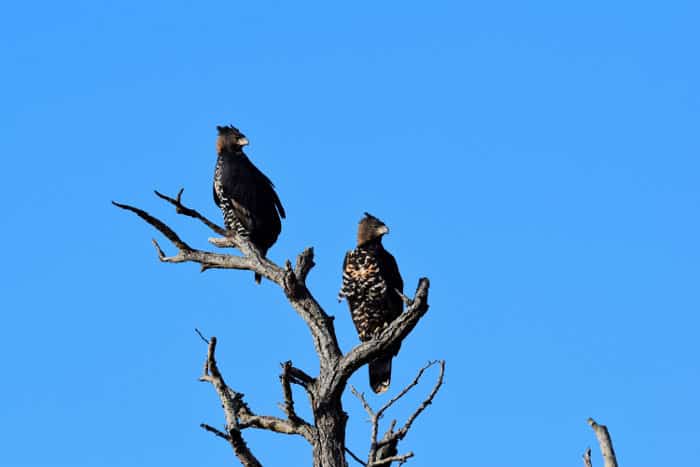
Sadly, these incredible birds are on the decline. They are classified as near threatened on the IUCN red list. Their population is decreasing and their habitat is being lost.
And we have been here before. Crowned eagles are the only existing member of the Stephanoaetus genus. There used to be another one, a Madagascan native known as the Malagasy crowned eagle. However, humans hunted giant lemurs into extinction, thus removing this eagle’s main food source.
Where do crowned eagles live?
These powerful eagles are dependent on tropical forest. They live and hunt from the trees, all across Sub-Saharan Africa.
Distinct populations live in West Africa, across the Congo Basin, Tanzania and Kenya, plus the eastern flanks of Southern Africa. Unfortunately, native forest is being wiped from the African continent, especially by mining, slash and burn farming. This loss of habitat has resulted in population decline.
Sadly humans are expanding at a rapid rate. Did you know that the human population has doubled in the last 50 years? Not only are the forests wiped out, urban areas have encroached on the forests that remain.
Conflict between crowned eagles and people
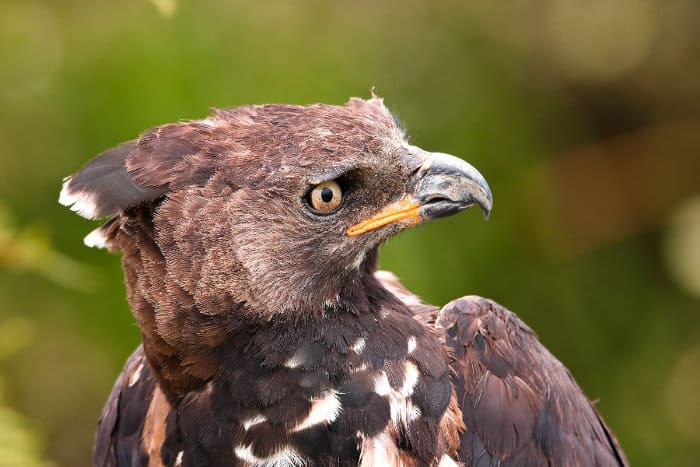
When people get too close to crowned eagles they become prey. A 7-year-old 20-kg boy was gouged through the throat and chest in South Africa (he survived). The skull of a human child has been found in a crowned eagle nest. A severed child’s arm was found in another tall tree, in a place inaccessible to leopards.
South Africa’s Kwazulu-Natal province has the highest crowned eagle density in the world. These birds are regularly spotted close to roads and live in the large city of Durban. They still hunt from the trees like they used to, but the city is now wrapped around the forest.
Juvenile crowned eagles in Durban have come into danger when hunting domestic pets, such as cats and dogs. Where farmland has replaced forest crowned eagles have been hunted by farmers, who see them as a threat to livestock.
Preserving Africa’s most powerful eagle
Now is the time to act, when active conservation can breathe life into a viable population.
Habitat conservation is essential. It’s the same story with most of Africa’s endangered animals. Protect the wilderness and we will protect the wildlife that lives there. Not only that, species like the crowned eagle will be able to thrive.

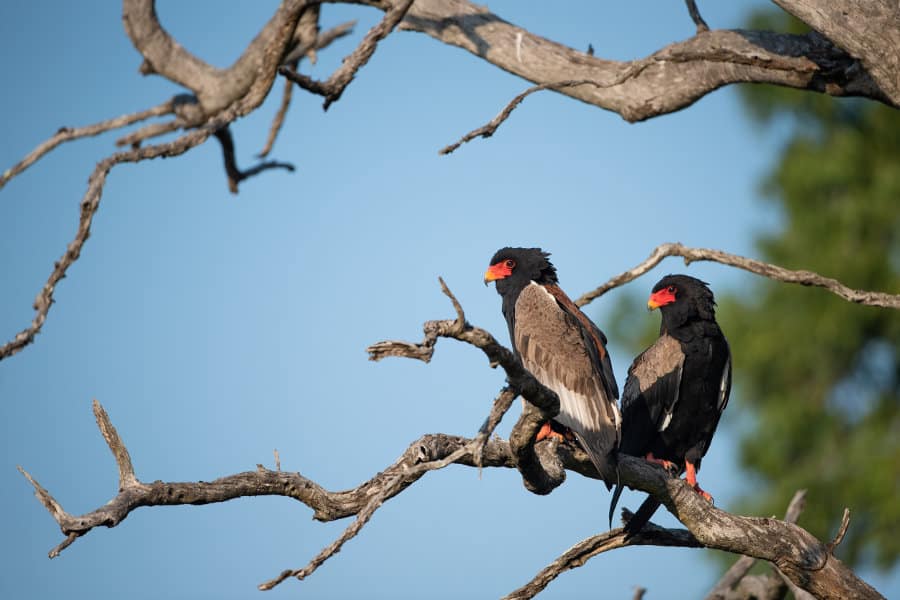

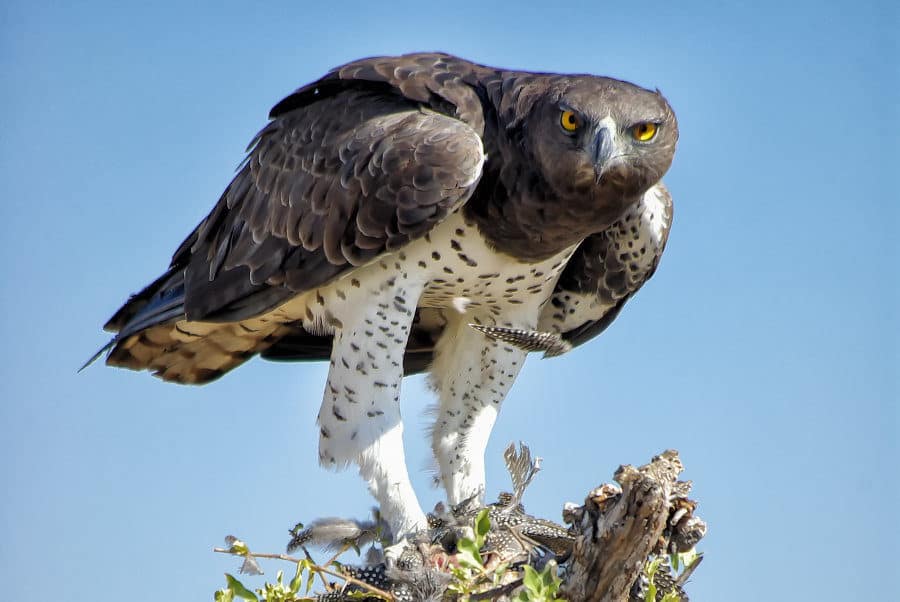
We often see mature Crowned Eagles in our area of Westville, adjacent to the Palmiet River and Nature Reserve. We have witnessed two Juvenile Crowned Eagles in the last 8 years, 1 in 2017 (K2 – red ring) and the other current one (GIN – purple ring) now in 2025. GIN often hunts in our area for Vervet Monkeys and Hadidas. GIN often sits in a Flat Top tree in our neighbours property for long periods of time, surveying what he/she can hunt. I have taken a number of photographs and videos and really treasure this magnificent raptor. Their calls are absolutely thrilling and very distinctive.
How lucky Elsje, thank you so much for sharing your stories about these majestic raptors.
It has been interesting information about birds of prey. I would wish to get more because am preparing to know much and educate the upcoming youths on the importance of having birds.